#Convention on the Rights of the Child (CRC)
Text
#UNICEF UK#job vacancy#Strategic Lead#UN Convention on the Rights of the Child#CRC#London#Permanent#Part home#Part office#£55#000 per annum#Advocacy work#child rights#UK Committee for UNICEF#UNCRC#legislation#policy#children#advocacy#rights#senior stakeholders#governments#public sector#civil society#apply online#closing date#interview date#pay#benefits#flexible working
0 notes
Text
Strengthen the meaningful engagement of girls and young women in all areas of public life, facilitating access to decision-makers.
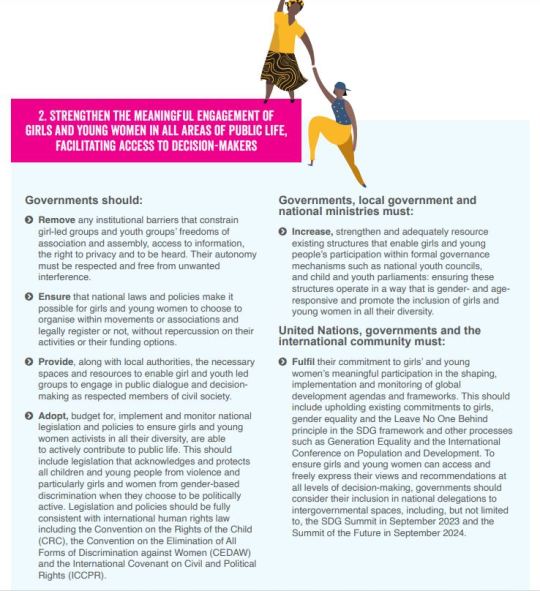
Governments should:
- Remove any institutional barriers that constrain girl-led groups and youth groups’ freedoms of association and assembly, access to information, the right to privacy and to be heard. Their autonomy
must be respected and free from unwanted interference.
- Ensure that national laws and policies make it possible for girls and young women to choose to organise within movements or associations and legally register or not, without repercussion on their
activities or their funding options.
- Provide, along with local authorities, the necessary spaces and resources to enable girl and youth led groups to engage in public dialogue and decision-making as respected members of civil society.
- Adopt, budget for, implement and monitor national legislation and policies to ensure girls and young women activists in all their diversity, are able to actively contribute to public life. This should
include legislation that acknowledges and protects all children and young people from violence and particularly girls and women from gender-based discrimination when they choose to be politically
active. Legislation and policies should be full consistent with international human rights law including the Convention on the Rights of the Child (CRC), the Convention on the Elimination of All
Forms of Discrimination against Women (CEDAW) and the International Covenant on Civil and Political Rights (ICCPR).
Governments, local government and national ministries must:
- Increase, strengthen and adequately resource existing structures that enable girls and young people’s participation within formal governance mechanisms such as national youth councils,
and child and youth parliaments: ensuring these structures operate in a way that is gender- and ageresponsive and promote the inclusion of girls and young women in all their diversity.
United Nations, governments and the international community must:
- Fulfil their commitment to girls’ and young women’s meaningful participation in the shaping, implementation and monitoring of global development agendas and frameworks. This should
include upholding existing commitments to girls, gender equality and the Leave No One Behind principle in the SDG framework and other processes such as Generation Equality and the International Conference on Population and Development. To ensure girls and young women can access and freely express their views and recommendations at all levels of decision-making, governments should consider their inclusion in national delegations to intergovernmental spaces, including, but not limited to, the SDG Summit in September 2023 and the Summit of the Future in September 2024.
#girl and youth led groups#decisionmaking#innovation for equality#international day of the girl child#adolescent girls#dayofthegirl#SDG Summit#Summit of the Future#Leave No One Behind#local government#national ministries#Convention on the Rights of the Child (CRC)#Convention on the elimination of all Forms of Discrimination against Women (CEDAW)#International Covenant on Civil and Political Rights (ICCPR)#State of the World's girls
0 notes
Text
I hope leftists realize that all the anti-education and especially anti-trans legislation in the States right now is not just anti-education and anti-trans but explicitly targeting minors’ rights and explicitly intended to reinforce the conservative Christian notion that a minor is the property of their parents and that parents have absolute control of their childs’ lives that the government cannot be allowed to interfere with.
This is why the US is the sole UN member that has not ratified the UN Convention on the Rights of the Child - the most widely-ratified UN convention - because conservatives believe it interferes with a parents’ authority.
“...organizations opposed to the CRC object particularly to the following articles: Article 13, freedom of expression; Article 14, freedom of thought, conscience, and religion; Article 15, freedom of association and peaceful assembly; Article 16, right to privacy; Article 17, access to information...”
(From ISLA Journal of Int’l and Comparative Law, “Who’s Afraid of the CRC?”)
All of the rights listed here are being attacked right now, particularly for trans minors. It’s not just that they hate trans people (they do), it’s that they do not believe that a minor has a fundamental right to autonomy, expression, identity, or access to information that a parent does not allow. It is absolutely not possible to fight for trans rights without fighting for minors’ rights.
(Edit:
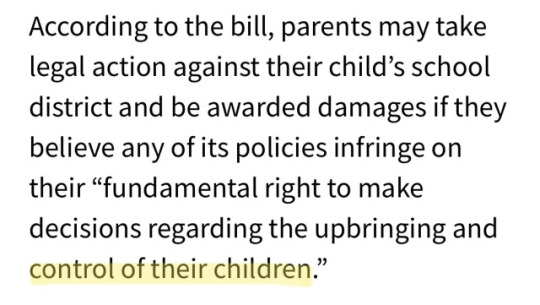
(From The Hill))
(From a different The Hill article - it’s incredible that he blatantly admitted that the purpose of calling it the Anti-Groomer Bill is so that anyone against the bill can be accused of being a groomer. He didn’t even attempt to hide the intention.)

235 notes
·
View notes
Text
2759th Meeting, 95th Session, Committee on the Rights of the Child (CRC).
Consideration of Congo (cont'd)
Description
The Committee on the Rights of the Child (CRC) is the body of 18 Independent experts that monitors implementation of the Convention on the Rights of the Child by its State parties. It also monitors implementation of two Optional Protocols to the Convention, on involvement of children in armed conflict and on sale of children, child prostitution and child pornography.
Over the past 30 years, children's lives have been transformed by the most widely ratified human rights treaty in history. The Convention on the Rights of the Child has inspired governments to change laws and policies, so more children get the healthcare and nutrition they need. There are better safeguards in place to protect children from violence and exploitation. More children have their voices heard and participate in society. But there is still more work to be done.
CRC 95th Session (15 Jan - 02 Feb 2024)
#Rights of the Child#Congo#children's lives#committee of the right of the child#children's issues#meetings#child protection
3 notes
·
View notes
Text
From the linked report:
"The protection of children from all forms of violence is a fundamental right, guaranteed by the Convention on the Rights of the Child (CRC)[1] and other international treaties
Violence can take different forms, can be perpetrated by dif- ferent individuals and can occur in different settings. Children who are exposed to or witness violence can experience acute and long-term damage to their physical, cognitive, social and emotional development. The consequences can be lifelong and transgenerational and lead to economic disadvantages and a reduced quality of life. Furthermore, evidence shows the association between exposure to violence in childhood (as a victim or witness) and the risk of experiencing or per- petrating violence during adolescence or adulthood.1 Hence, violence against children has far-reaching costs for society, slowing economic development and eroding nations’ human and social capital.
In 2015, with the launch of the Sustainable Development Goals (SDGs), the global community made a commitment to end all forms of violence against children by 2030. The SDGs include specific targets for measuring progress in this regard. In particular, Goal 16, on promoting just, peaceful and inclusive societies, includes two targets that explicitly relate to violence: target 16.1, “Significantly reduce all forms of violence and related death rates everywhere” and target 16.2, “End abuse, exploitation, trafficking and all forms of violence and torture of children”. Although the inclusion of these targets2 draws much needed attention to the importance of preventing and respond- ing to violence against children, the availability of comparable data remains limited."
As a leftist, one of my frustrations with the media of radical critique is its frequent neglect if not obliviousness to the social measurement movement - the attempt by social scientists and activists to quantify social realities in order to give policy makers and change seekers the evidence they need to press for reform.
The flagship example of this is the UN's Human Development Reports (HDR): https://hdr.undp.org. These are excellent global surveys of wide ranging social data. If you want to construct a broad picture of where our species is at across many domains of inquiry and ethical concern, start with these reports.
There exist many other social indices, and any number proposed in theory. The fact that these are not widely known in left circles, let alone used for political purposes, is an ongoing puzzle and frustration to me.
In any case, the ICVAC seems to me to be a landmark document that can direct attention and resources at what must be a top priority - the protection and care of children, and the reform of all practices and systems that would abuse and neglect them.
[1] And, of course, the US refuses to ratify the Convention. https://en.wikipedia.org/wiki/Convention_on_the_Rights_of_the_Child#United_States : "The United States government played an active role in the drafting of the convention and signed it on 16 February 1995, but has not ratified it. It has been claimed that American opposition to the convention stems primarily from political and religious conservatives."
2 notes
·
View notes
Text
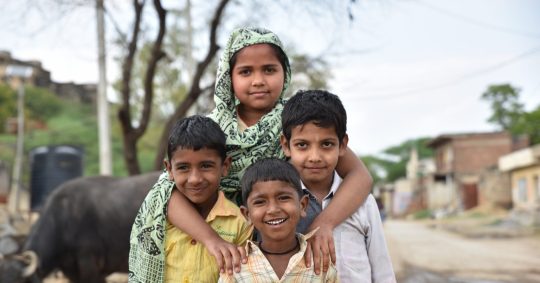
WHOSE CHILDREN ARE THEY ANYWAY ?
I fondly remember a conversation between a four-year-old girl and her father on her first train journey in 2018. The moment the train left the station, the child was jubilant and jumped to tell her father, ‘Daddy, the train station is moving away from us.’ After a brief conversation, the father convinced his daughter that it was not the train station that was moving; instead, the train was leaving the station.
Another incident that intrigued me during my primary research on children was in the refugee pockets in Jammu. Families had fled from countries like xxxx, many children were born in refugee camps. Until reality hit the child, he believed that his refugee country was his place of residence and identity. This belief was shattered when these children were confronted with the reality that they were merely refugees who did not belong to their land of birth. Instead, they are looked at as citizens of a country from where their parents were forced to flee due to the fear of persecution, and they are now, technically stateless to say the least.
Both incidents reflect the innocent perception of a child’s own life and their confrontation with reality. For the girl on board the train, her exposition to the fact is an empowering choice of knowledge. At the same time, in the latter case, it is a political vindication of identity subsumed in the unqualified denial of access of the most fundamental guarantees by either or both, the host or the country of refugee – citizenship, statehood, identity and access to the most fundamental entitlement which will eventually empower the child: health and education.
The former three concerns are fenced around the political contours of the State’s recognition, majoritarian will and populism, while the latter (health and education) establish the first foundational relationship between the State and the child as an empowering right to grow up as an adult.
The Question ?
Should primary health and education be marred by the earlier three paradigms of citizenship, Statehood and identity or, this should remain independent as a non-derogable entitlement in the best interest of the child and thus calling upon the receiving states to provide these most basic entitlements as a right, irrespective of the citizenship of the child.
One argument espoused is that the receiving State is under no obligation to provide anything. There are international agencies like the UNHCR and other non-profits organizations to address these issues. Second, the people who have sought temporary refugee will eventually return to their own country. Thirdly, the apprehension that if the State extends national initiatives like primary education and health, they may settle within the comfort of their new country, putting an additional burden upon the receiving State. Fourth, and most rhetorically proclaimed, their permanent presence poses a security risk, and therefore they must be eventually deported. Nationalism is a resounding discourse. Finally, the receiving State has not signed the refugee convention (case basis) and thus is under no obligation.
Another side of the coin is the receiving State’s obligation under the UN Convention on the Rights of the Child and its responsibility in a globalized world to protect, respect and fulfil the customary guarantees of primary health and education, irrespective of Statehood or citizenship
The best’ interest principle’ in the UN-CRC fuses the law’s protection and empowering spirit under one umbrella. Protection as a negative obligation dovetails a guardianship network against arbitrary State action through parents, village elders, autonomous and State institutions, etc. Empowerment remains fluid and risks undermining the non-derogable nature of the Convention since it seamlessly yet dangerously seeps within the larger paradigm of Economic Social and Cultural Rights (ESC) as a positive obligation limited to the availability of maximum available resources. The absence/lack of the binding nature of ESC rights (e.g. health and education) fails the child in its entirety when the Convention does not create capacity to ensure the child’s transition to adulthood, enjoy the availability of choices and the freedom to choose. Second, it risks creating an unhealthy and uneducated population.
Primary data analysis of the refugee children in Jammu shows 886 school dropouts out of the total of 2073 children are engaged in child labour. Amongst the school-going children, 59% of the children are going to linguistic or refugee run community schools. After calculating the school dropouts in various classes, only 25 children out of 2073 will fulfil the minimum criteria to apply for jobs in the future.
In terms of health, no birth registration is carried out. Instead, an affidavit is prepared by the families to confirm the birth. The immunization rate is extremely low since they are not covered under the universal immunization scheme. India’s immunization rate is more than 82% in all vaccination programs. In contrast, for the documented refugee population, the rate is abysmally low to a maximum of 60% in the case of OPV (oral polio vaccine) to a low of 1.5% for measles-rubella (MR) vaccination.
State reluctance to extend minimum human rights guarantees to the population citing the oft-quoted risk of granting permanency to an otherwise refugee population is likely to have a disparate impact on children in future. Rampant child labour and exploitation is prevalent with negligible access to state-sponsored health and education. With more than 50% of the present population being children and 20% within the above 50% being born in India will also raise questions on their citizenship in future.
History is replete with examples that refugees have rarely returned to their native country. They have seldom mainstreamed with the country of refugee and instead, such refugee camps have mushroomed as ghettos with people living in abject poverty. In the absence of any State intervention, they are an undocumented population vulnerable to exploitation.
This is a question of trade-off: recognizing children’s basic entitlement to health and education opens up a pandora box of state obligations to non-citizens best explained by the famous phrase: ‘Rob Peter to pay Paul’.’ On the other hand, denial of these basic rights to children does not auger well for the receiving State too. Over the years, many of these young children as adults could be termed anti-national/anti-social elements without the slightest recognition that it was the absence of minimum public education guarantees that these children were left with no choice. Similarly, the unhealthy population will even work unworthy and unskilled. Very few will therefore be able to deflect from the vicious cycle of poverty and unemployment in the absence of State intervention. The rest of the population will fringe to the essentially de facto segregated spaces, which will become ghettos.
0 notes
Text
Adopt the International rules and standards for policing.
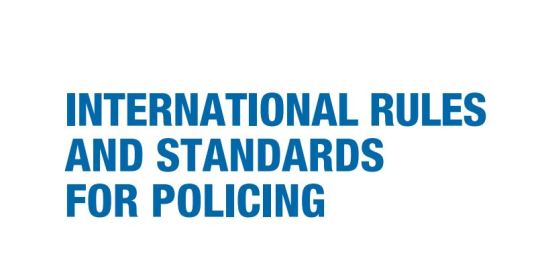
The overall objective is to promote respect for the law that protects people in such circumstances.
The United Nations was created in 1945 in order to
promote and maintain peace and security. Its founding
instrument is the Charter of the United Nations (UN Charter).
This document contains an important commitment to
human rights in Article 55.
Three major instruments that codified human rights at the
universal level together form what is often referred to today
as the International Bill of Human Rights:
The Universal Declaration of Human Rights (UDHR), which was adopted by the General Assembly of the United Nations in 1948;
The International Covenant on Economic, Social and Cultural Rights, which was adopted in 1966, and its Optional Protocol of 2008;
The International Covenant on Civil and Political Rights, which was adopted in 1966, and its two Optional Protocols.
The UDHR had a major impact on subsequent universal and
regional human rights treaties as well as on national constitutions and other laws. As a consequence, there are a number of provisions that can today be considered customary law, e.g. the prohibition of torture and other forms of ill-treatment, the prohibition of racial discrimination and the prohibition of slavery. Following the International Bill of Human Rights, a number of treaties were drafted that dealt with specific topics. They include the following:
International Convention on the Elimination of All Forms of Racial Discrimination (CERD);
Convention on the Elimination of All Forms of Discrimination against Women (CEDAW) and its Optional Protocol;
Convention against Torture and Other Cruel, Inhuman or Degrading Treatment or Punishment (CAT) and its Optional Protocol (OPCAT);
Convention on the Rights of the Child (CRC) and its Optional Protocols on the involvement of children in Charter of the United Nations, Article 55 “The United Nations shall promote […] universal respect for, and observance of, human rights and fundamental freedoms for all without distinction as to race, sex, language, or religion.”
International law on armed conflict and on the sale of children, child prostitution and child pornography.
International human rights treaties that are binding on all States Parties (and their agents) are increasingly complemented by soft law documents that provide guidance and establish more detailed human rights standards. In addition to the two soft law documents already mentioned (CCLEO and BPUFF), the following soft law documents, are of particular relevance to law enforcement officials:
Standard Minimum Rules for the Treatment of Prisoners (SMR);
Body of Principles for the Protection of All Persons under Any Form of Detention or Imprisonment;
Declaration of Basic Principles of Justice for Victims of Crime and Abuse of Power (Victims Declaration)
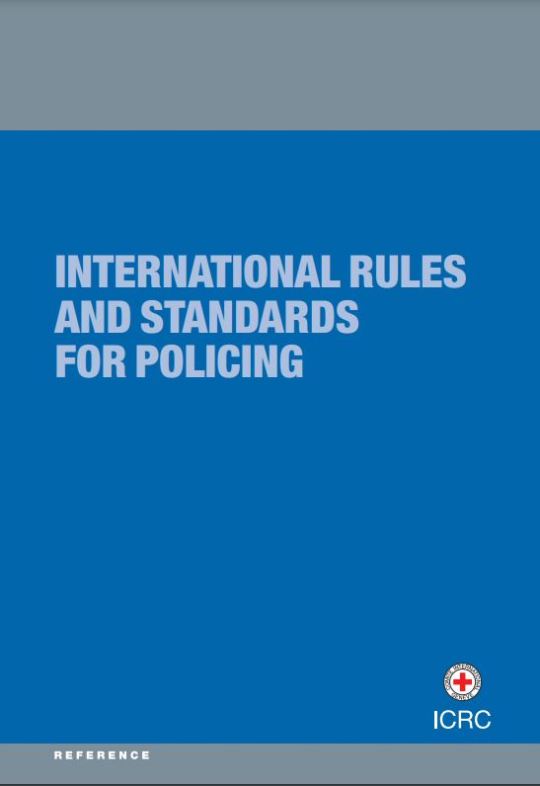
#International law#international human rights law#law enforcement#law#enforcement agencies#armed conflict#situation of violence#protectunstaff#unpersonnel#unstaff#Humanity#impartiality#neutrality#independence#voluntary service#unity#universality#humanitarian organizations#law enforcement organizations#International human rights treaties
0 notes
Text
SUDARSHAN LIVE KHABAR LOBBY
Sudarshanlive:17/01/2024, international news updates, report by-united nation’s,
The 95th session of the UN Committee on the Rights of the Child is currently underway in Geneva.Here are 5️⃣ facts about the CRC:1. CRC is a UN body of experts ensuring that every child’s rights are protected globally.2. CRC reviews reports from countries, holding them accountable for implementing the Convention on…

View On WordPress
0 notes
Text
Children Legal Rights
Children's legal rights are a set of fundamental entitlements designed to protect and promote their well-being, development, and dignity. These rights are recognized and enshrined in various international treaties and conventions, with one of the primary instruments being the United Nations Convention on the Rights of the Child (CRC). Some key aspects of children's legal rights include:
Right to Life, Survival, and Development:-
Children have the right to life and to live in an environment that supports their survival, growth, and development.
Right to Education:-
Every child has the right to free and compulsory education, ensuring access to learning opportunities that contribute to their intellectual and social development.
Right to Health:-
Children are entitled to the highest attainable standard of health, including access to healthcare services, clean water, and proper nutrition.
Protection from Discrimination:-
Children have the right to be protected from discrimination based on factors such as race, color, gender, religion, disability, or other status.
Protection from Abuse and Exploitation:-
Children have the right to be protected from all forms of abuse, neglect, exploitation, and harmful practices.
Right to a Family Environment:-
Children have the right to live with their parents unless separation is necessary for their best interests. Even in cases of separation, the child has the right to maintain contact with both parents.
Right to Participation:-
Children have the right to express their views in matters affecting them, and their opinions should be given due weight in accordance with their age and maturity.
Juvenile Justice Rights:-
Children accused of crimes have specific rights within the juvenile justice system, emphasizing rehabilitation and protection rather than punishment.
Right to Privacy:-
Children, like adults, have a right to privacy, protecting them from unwarranted intrusion into their personal lives.
Preservation of Cultural Identity:-
Children have the right to maintain their cultural identity, including language, religion, and heritage.
Children's Legal Rights collectively aim to create an environment that nurtures children's physical, emotional, and cognitive development while safeguarding them from harm. Upholding and respecting children's legal rights is essential for fostering a just and supportive society. It is the responsibility of governments, communities, and individuals to ensure that these rights are not only recognized on paper but actively promoted and protected in practice.
For More Information Please Visit us:- https://youthlegalserviceinc.com.au/donate/
0 notes
Text
ළමා අයිතිවාසිකම් පිළිබඳ එක්සත් ජාතීන්ගේ සම්මුති සංවත්සරය - නොවැම්බර් 20
ළමා අයිතිවාසිකම් පිළිබඳ එක්සත් ජාතීන්ගේ සම්මුති සංවත්සරය - නොවැම්බර් 20
UNICEF සංවිධානයේ ශ්රී ලංකා නියෝජිත ක්රිස්ටියන් ස්කූග් මහතාගේ සම්පූර්ණ නිවේදනය.
1989 වසරේ නොවැම්බර් මස 20 වන දින, ලෝක නායකයින් එක්ව ළමා අයිතිවාසිකම් පිළිබඳ එක්සත් ජාතීන්ගේ සම්මුතිය (Convention on the Rights of the Child – CRC) ඇති කරගනු ලැබීය. ළමා අයිතිවාසිකම් පිළිබඳ එක්සත් ජාතීන්ගේ සම්මුතිය (CRC) තුළින් සෑම දරුවෙකුටම ඔහුගේ හෝ ඇයගේ අයිතිවාසිකම් ආරක්ෂා කිරීමට සහ එය ඉටු කරදීමට පොරොන්දුවක් ලෙස එම…
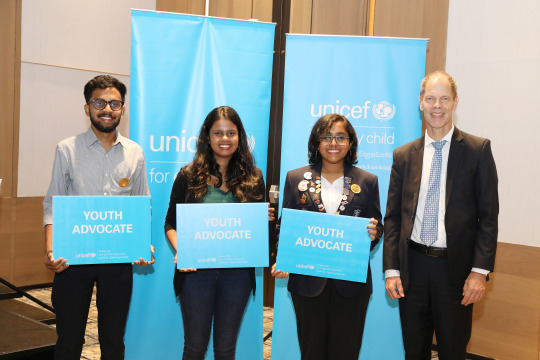
View On WordPress
0 notes
Text
Grace Tame
Grace Tame is an Australian award winning motivational speaker, author, influencer, activist and advocate for survivors of sexual assault particularly those who were abused as children. Grace is a 28 year old woman who is part of the neurodiverse community. Grace is a leader of positive change. Grace was diagnosed with autism at the age of 20 while she was overseas. Grace has struggled a lot in life due to being molested at the age of six and sexually assaulted in April of 2010 in year 10 at her high school in Tasmania. Grace has now made a career out of advocating for survivors of sexual assault by trying to change "sex abuse laws across Australia" (News, 2023). Grace is an exceptional communicator, capable of delivering a clear, powerful message and talking about her own personal trauma in a way that doesn’t alienate her audience. In 2021 Grace was announced Australian of the year. Grace has created a foundation called "The Grace Tame Foundation" which aims to ensure the "Australian Government and Governments of States and Territories take appropriate action by enacting laws, delivering educational programs and encouraging social behaviours" (The Grace Tame Foundation, 2023). "It also promotes attitudes that fulfill obligations to ensure the right of children to be safe no matter where they are as per the UN Convention on the Rights of the Child (CRC)" (The Grace Tame Foundation, 2023). "The Foundation also raises funds to support other projects and initiatives through grants. It seeks to partner with and support existing organisations and programs which align with the Foundation’s purpose" (The Grace Tame Foundation, 2023). Grace is a leader of positive change.
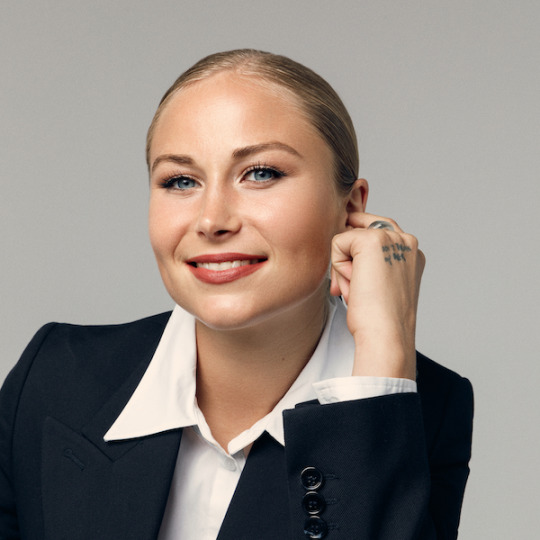
0 notes
Text
The Only Nation Not Agreeing to Protect Kids: US?
“Once we were slaves…”
-Apparently, kids are still slaves in many states.
But what is shocking, and humiliating, is that no state in the USA is fully compliant, even up to a Passing Grade level, with the requisites of the Convention on the Rights of the Child (CRC). Maybe that explains why the USA is the only UN member nation not to have ratified this basic treaty. As an American…

View On WordPress
0 notes
Text
Problematika Dispensasi Perkawinan
Perkawinan anak dibawah umur merupakan sebuah praktik yang sudah sering dilakukan di Indonesia dari zaman nenek moyang hingga sekarang, namun sekarang dibungkus dengan kata yang lebih modern yaitu “Dispensasi Perkawinan”
[[MORE]]
Menurut data yang penulis dapatkan dari laman Kompas bahwa ada sebanyak 868 pelajar mengajukan dispensasi perkawinan, 572 pelajar diantaranya berasal dari Indramayu, 125 pelajar dari Ponorogo dan 171 pelajar dari Gunung Kidul pada tahun 2022. Alasan mengapa anak anak dan orang tua mengajukan dispensasi perkawinan adalah karena sang anak telah hamil diluar perkawinan, takut sang anak menimbulkan aib bagi keluarga dan sang anak ingin melanjutkan hubungan yang lebih serius dengan pasangannya.
Menurut Pasal 7 Ayat (1) Undang Undang №16 Tahun 2019 jo. Undang Undang №1 Tahun 1974 tentang Perubahan atas Undang Undang Perkawinan “Perkawinan hanya diizinkan apabila pria dan wanita sudah mencapai umur 19 (sembilan belas) tahun.” namun ayat (2) dan (4) nya sangat bertentangan dengan ayat (1) pasal tersebut dimana dikatakan bahwa orang tua pihak pria dan/atau orang tua pihak wanita dapat meminta dispensasi kepada Pengadilan dengan alasan sangat mendesak disertai bukti-bukti pendukung yang cukup dan juga, keadaan orang tua/wali si anak dapat dijadikan “alasan mendesak” untuk dilangsungkannya perkawinan.
Kita dapat melihat ketidakkonsistenan pemerintah dalam memberantas praktik perkawinan anak dibawah umur dan terdapat ketidakpastian hukum pada frasa “alasan mendesak” yang dianggap terlalu multitafsir dan tidak ada penjelasan mengenai pasal tersebut sehingga dalam mempertimbangkan segala hal Hakim menggunakan subyektifitasnya sendiri dan sudah pasti akan dikabulkan. Jadi seorang anak yang belum berusia genap 19 tahun dapat mengajukan dispensasi perkawinan dengan alasan apapun termasuk alasan ekonomi dan sudah pasti diterima. Pemerintah harus dapat memperbaiki frasa tersebut atau ditambahnya pasal penjelas agar tidak menjadi boomerang bagi negara di kemudian hari.
Dispenasi perkawinan ini dianggap sebagai pelanggaran terhadap hak hak anak karena sang anak akan terpaksa kehilangan beberapa hak penting seperti hak untuk melangsungkan pendidikan, hak atas kebebasan dan hak atas kesehatan serta bertentangan dengan Convention on the Rights of the Child (CRC) dan Undang Undang №35 Tahun 2014 tentang Perubahan atas Undang-Undang Nomor 23 Tahun 2002 Tentang Perlindungan Anak, Pasal 26 Ayat (1) huruf c yang mengatakan bahwa orang tua bertanggung jawab untuk mencegah perkawinan anak dibawah umur.
Faktor Terjadinya Perkawinan Anak Dibawah Umur
perilaku seksual dan kehamilan yang tidak diinginkan;
tradisi atau budaya;
rendahnya pengetahuan terkait kesehatan reproduksi atau seksualitas dan rendahnya pendidikan orang tua;
faktor sosial ekonomi dan geografis;
lemahnya penegakan hukum
Konsekuensi dari Perkawinan Anak Dibawah Umur
Meningkatnya risiko komplikasi medis kehamilan yang dapat mengakibatkan kematian pada ibu dan anak dan juga dapat mengakibatkan penyakit obsetric fistula (kerusakan pada organ kewanitaan)
Anak tidak dapat melanjutkan pendidikan
Meningkatnya angka kemiskinan
Perampasan kebebasan anak
Permasalahan psikis
Kekerasan dalam Rumah Tangga (KDRT)
Meningkatnya angka perceraian
Jika dispensasi perkawinan ingin dihapuskan sudah pasti akan bertabrakan dengan aspek agama sehingga untuk sementara waktu solusi yang dapat penulis berikan adalah sebagai berikut :
Memperbaiki frasa "alasan mendesak" pada Pasal 7 Ayat (2) Undang Undang Perkawinan atau memasukan penjelasan pada pasal penjelas agar tidak terjadi multitafsir / tafsiran yang sangat luas.
Memasukan Sex Education dalam kurikulum sekolah yang nantinya akan diajarkan oleh orang yang memiliki sertifikasi dalam bidang tersebut, pelajaran tersebut harus mencakup pembahasan mengenai risiko risiko pernikahan dini.
Pemerintah harus menetapkan sebuah peraturan dimana pihak pria wajib memenuhi kebutuhan hidup sang wanita pra dan pasca melahirkan, serta kebutuhan hidup sang bayi.
Pemerintah dapat berperan dalam menyediakan fasilitas konseling dan homeschooling gratis agar anak anak yang putus sekolah tetap bisa melanjutkan pendidikan dalam keadaan apapun dan harus dipastikan bahwa anak anak tersebut telah lulus sekolah, setelah dirasa umur si pria dan wanita telah memenuhi syarat pada Pasal 7 ayat (1) dan telah mendapatkan pekerjaan yang layak baru mereka boleh melangsungkan perkawinan.
Referensi
Hendra, T., & Hayyuning, J. (2022). Seksualitas dan Negara : Permasalahan Dispensasi Perkawinan Anak di Indonesia Sexuality and the State : Dispensation of Child Marriage in Indonesia.
Iustitiani, N. S. D., & Ajisuksmo, C. R. P. (2018). Supporting Factors and Consequences of Child Marriage. ANIMA Indonesian Psychological Journal, 33(2), 100–111. https://doi.org/10.24123/aipj.v33i2.1581
Judiasih, S. D., Padjadjaran, U., Dajaan, S. S., Padjadjaran, U., Nugroho, B. D., & Padjadjaran, U. (2020). PERKAWINAN BAWAH UMUR DI INDONESIA. Jurnal Ilmu Hukum Kenotariatan Fakultas Hukum Unpad, 3(2), 203–222.
Muqaffi, A., & Rahmi, D. (2021). Revisi UU Perkawinan. 5(3), 361–377.
0 notes
Text
2762nd Meeting, 95th Session, Committee on the Rights of the Child (CRC).
Consideration of Bulgaria.
The Committee on the Rights of the Child (CRC) is the body of 18 Independent experts that monitors implementation of the Convention on the Rights of the Child by its State parties. It also monitors implementation of two Optional Protocols to the Convention, on involvement of children in armed conflict and on sale of children, child prostitution and child pornography.
Over the past 30 years, children's lives have been transformed by the most widely ratified human rights treaty in history. The Convention on the Rights of the Child has inspired governments to change laws and policies, so more children get the healthcare and nutrition they need. There are better safeguards in place to protect children from violence and exploitation. More children have their voices heard and participate in society. But there is still more work to be done.
CRC 95th Session (15 Jan - 02 Feb 2024)
#Committee on the Rights of the Child#consideration#bulgaria#children's issues#child rights#meetings#child protection#independent experts
0 notes
Text
OCCUPATIONAL BARRIERS EXPERIENCED IN MENTAL HEALTH IN SA
To be able to function optimally in your daily occupations your mental health should be taken care of. According to world health organization (WHO,1948) health is a complete physical, mental and social well-being not merely an absent of disease and illness or infirmity.

the right to experience the highest level of quality that is possible of physical and mental health (from here on, the right to health) is enshrined in many international and regional human rights treaties, such as the International Covenant on Economic, Social and Cultural Rights (ICESCR); the Convention on the Rights of the Child (CRC); and the Convention on the Rights of Persons with Disabilities (CRPD); the African Charter on Human and Peoples’ Rights (ACHPR); and the African Charter on the Rights and Welfare of the Child (ACRWC).1
In 2004, the South African Mental Health Care Act became effective (South African Department of Health,2009). The Act's goal is to regulate mental health services "in a manner that makes the optimum mental health care, treatment, and rehabilitation services available to the community equitably, efficiently, and in the best interest of mental health care consumers within the limits of the available resources." 3
The right to health includes both physical and mental health, thus:
… efforts to recognize and uphold a human right to health must incorporate strategies to protect, respect, and fulfil mental health as well as physical health. Establishing and upholding affirmative mental health rights can fundamentally advance the dignity and welfare of persons with mental disabilities, and, simultaneously, advance the recognition and development of the right to health generally. (L. Gable et al.2009)
most occupational barriers included traditional cultural beliefs of the community, most people in my neighborhood (KZN) believe in ancestors, thus when they are ill or feeling unwell, they usually go and consult to a traditional healer first due to having that belief that an illness is just a curse/punishment from ancestors so you might need to ask for forgiveness. They believe traditional healer have answers and can communicate to their ancestors. If the ancestors need something from them/require them to slaughter or do something they communicate with the traditional healers to stop an illness or fix whatever is happening.
lack of transport: most of the people when they are found to have a mental illness, they travel using a police vehicle and they are always handcuffed to avoid them from running away or jumping from the police van.
lack of facility: in my area (KZN), people use the nearest clinic which has the limited staff so to get to the hospital is +/-40 km which is a long distance from their home and most of their wake up early to catch a bus which deprived them from getting enough hours of sleep.
financial issues: some people may not have money to transport themselves to the hospital when wanting to access medical services, they might receive disability grant but the people I know spend the money to buy grocery and taking care of the whole household but when it comes to going to the hospital, they end up borrowing money for it.
Education: Because lot of people lack knowledge about mental health and mental illness most people have stigma towards mentally ill people, some of them run away and even taught their children to do the same from mentally ill people, which is wrong because they are also human beings like us.
Following the ground-breaking World health report 2001 on mental health, issued by the World Health Organization (WHO), global initiatives have been taken to raise awareness of mental health and improve the status and health care of people with mental disabilities both in law and in fact, such as the CRPD and the WHO mental health Gap Action Programme (mhGAP).(WHO,2008)
you can follow the link below of the article that talks about barriers in accessing or receiving mental health in the Eastern Cape province:
some of the tips in to improve your mental health
-take care of your body by doing exercises, eating healthy, drinking water, getting enough sleep and avoiding use of substances e.g. smoking
-value yourself by treating yourself with kindness, be proud of you and what you have accomplished
-Surround yourself with good people- that will change your way of thinking, people who will help you grow and do better as a person.
-Help others and ask for help when you need it-sometimes helping others can make you feel good as a person and also asking for help it means you are able to humble yourself to other people and ask for help which is a strength not a weakness.
-Set realistic goals-you can decide what you want to achieve academically, personally or professionally which will help you in terms of getting a sense of accomplishment and self-worth as you progress towards your goal.
Some of the benefit of taking care of your mental health is that it could help you manage anxiety/ stress, helps to lower the risk of developing any illnesses and increase your mood or energy which helps you to think positive and be able to be productive.
References
1. International Covenant on Economic, Social and Cultural Rights (ICESCR), G.A. Res. 2200A (XXI) (1966). Available at http://www.ohchr.org/EN/ProfessionalInterest/Pages/CESCR.aspx; Convention on the Rights of the Child (CRC), G.A. Res. 44/25 (1989). Available at http://www.ohchr.org/EN/ProfessionalInterest/Pages/CRC.aspx; Convention on the Rights of Persons with Disabilities, G.A. Res, 61/106 (2006). Available at http://www.ohchr.org/EN/HRBodies/CRPD/Pages/ConventionRightsPersonsWithDisabilities.aspx; African Charter on Human and Peoples’ Rights, OAU Doc.No.CAB/LEG/67/3 rev. 5 (1981). Available at http://www1.umn.edu/humanrts/instree/z1afchar.htm; African Charter on the Rights and Welfare of the Child, OAU Doc. No. CAB/LEG/24.9/49 (1990). Available at http://www1.umn.edu/humanrts/africa/afchild.htm.
2. South African Department of Health, Mental Health Care Act (No. 17 of 2002) (Pretoria, South Africa: Department of Health, 2002).
3. Ibid., section 3(a)(i).
4. L. Gable and L. Gostin, “Mental health as a human right” in A. Clapham, M. Robinson, C. Mahon, et al. (eds), Realizing the Right to Health (Zurich, Switzerland: Rüffer & Rub, 2009), p. 250.
6. World Health Organization (see note 4); World Health Organization, mhGAP Mental Health Gap Action Programme. Scaling up care for mental, neurological, and substance use disorders (Geneva: WHO, 2008). Available at http://www.who.int/mental_health/mhgap_final_english.pdf.
0 notes
Text
Research & Evaluation Specialist
Research & Evaluation Specialist
JOB DESCRIPTION
The Country Programme of Cooperation between the Government of Mozambique and UNICEF (CPD) for 2022-2026 aims to support Mozambique to accelerate efforts towards achieving the targets of the 2030 Agenda for Sustainable Development and meeting its commitment to respect, protect and fulfil the rights of children, in line with the Convention on the Rights of the Child (CRC) and the…

View On WordPress
0 notes